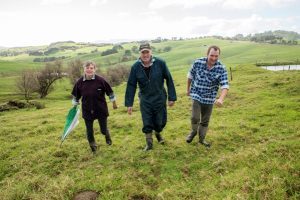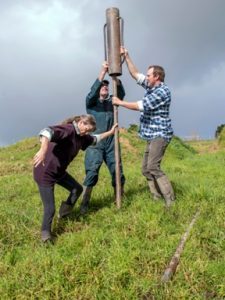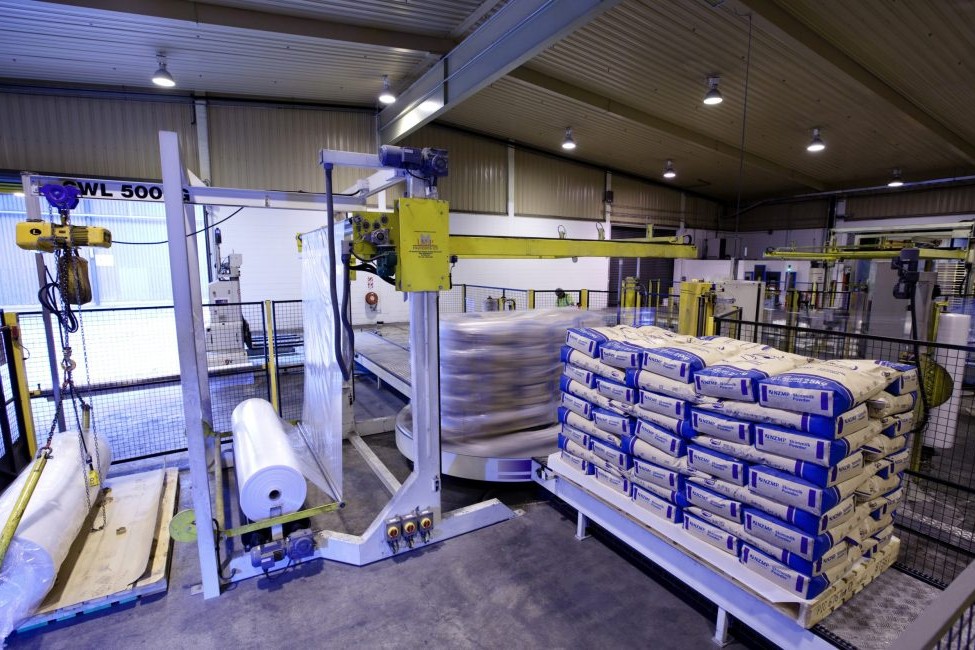Northland’s Phillips family have farmed the length of the North Island and now see their oldest son making progress towards succession. Glenys Christian reports.
Doug and Glenys Phillips have more than enough dairy farming experience having developed 16 different properties throughout most of the North Island.
But they want their older son, Kent, 31, who has just started 39% sharemilking on their 146-hectare Northland farm, to benefit from input from other farmers and consultants. So they were quick to sign up as one of the dairy farms taking part in DairyNZ’s Extension 350 programme.
“It’s a great opportunity for him to take a big step forward,” Doug said.
“We’d recommend it to anyone who wants to grow their business.”
As a mentor himself on a local farm he’s well aware of the positive impact brought about by discussing ideas with a wide audience before putting them in place. And with a DairyNZ analysis carried out of every onfarm move planned there’s nothing left to chance.
‘In the wet you can double your boot size just walking through the paddock in the limestone area.’
Doug left school at 15, progressed to lower-order sharemilking and bought his first herd in Taranaki at 30. Two years later he moved to Rerewhakaiitu, near Rotorua, to another 50:50 sharemilking position before he and Glenys came to Northland. They sharemilked for seven years for the Pouto Topu A Trust, the same property where the 2018 Sharemilkers of the Year, Dan and Gina Duncan, are now sharemilking.

While there they bought a farm at Mahuta, further north on the peninsula, and put a sharemilker on. After buying two neighbouring farms and leasing another, they ran a total of 500 split-calving cows and then moved there themselves to complete the development.
Their next move was to the Wairarapa – “for the green grass and the water,” Glenys says.
There they bought and sold five farms and runoffs in the Eketahuna/Mount Bruce area, developing each while milking 200 cows and rearing 200 calves.
Kent, who always intended to go farming, attended Taratahi Training Institute in Masterton in 2004 then worked as farmhand, assistant and manager on the farms as they developed them. Between farms he went to Taranaki as a herd manager on a farm milking 330 cows, then returned to the Wairarapa to a 450ha farm milking 500 cows and also running 700 head of drystock.
Coming into the job mid-season he worked there for two and a half years then spent a season on one of the family’s 200-cow farms before moving to Northland where his parents had moved the previous season. They’d bought a 200-cow Ruawai farm along with the existing herd, producing 322 kilograms of milksolids (MS) per cow with an empty rate of 3% and just one lame cow.
An Arapohue farm which caught their eye came on to the market as a mortgagee sale. Doug and Glenys moved on to that, repeating the pattern of spending 12 months developing and getting the farm in order, moving Kent up to manage the Ruawai farm. They then sold the Ruawai farm as a going concern in June 2016 and Kent progressing to 39% sharemilking on the Arapohue farm.

The herd they put together for their new farm from cows purchased locally balked at the approach to the dairy which they needed to negotiate in single file because of the state of the races. The concrete feedpad which hadn’t been used in some time was repaired with feeding bins reinstated. They also constructed a weeping wall with the concrete pad to be extended in the future. A lot of fencing on the farm also had to be renewed.
“There were 1.2-ha paddocks for 300 cows which were too small,” Doug says.
Instead of the original 75 when they arrived they now have just 52.
A new effluent system was required so a 120-day storage pond went in together with a pontoon pump and stirrer. The effluent area increased from 6ha to the present 22ha with the aid of two Stringray cannons, which can deal with the hillier contour of the farm and there were also issues with power and water to fix.
“We were just bringing everything up to a level where it was workable,” Glenys says.
The 24-aside herringbone dairy, which had been recently built, was the exception.
“It’s built to be very easy to work in, and to clean,” Kent says.
The Jersey-based herd was made up of 220 cows calving from July 23 and 85 carryover cows.
But the decision was quickly made to transition to a full autumn-calving herd, starting on March 1, with the last of the spring-calvers on the farm this year.
“It costs just as much to feed a cow during the summer dry,” Doug says.
“But you are getting a premium for the milk you’re producing in the winter.”
In much of Northland farmers can grow more grass in winter, Kent says.
The accessible areas of the milking platform are mulched annually and oversown with Tama annual ryegrass which they find can stand the prevailing southwesterly wind and competes well with the kikuyu.
There’s another factor which comes into play, which is the split soil types on the farm with heavy limestone clay in the front and a lighter volcanic clay at the back.
“In the wet you can double your boot size just walking through the paddock in the limestone area,” Glenys says.
They have been block soil testing, finding Olsen P levels which ranged from 17 to 55, but are now getting to the stage where they are close to being able to test at a paddock level. They used 600kg/ha of Super10 as an initial fertility booster and now their annual fertiliser is as per recommendations but put on a blanket application of 50kg/ha of urea by helicopter in June and August.
“We used a bit more this year with 100kg/ha of Phased N applied in June and 70kg/ha of nitrogen going on in August,” Kent says.
Another 30kg/ha will be applied little-and-often behind the milking herd.
Since being on the farm they’ve put in 3000 native plants on riparian strips, including manuka, flax, koromiko and cabbage trees all supplied free by Te Arai Nurseries under a scheme being taken up by more and more Northland and Auckland farmers.
More than 100 poplar poles are to go in on slip-prone areas on the farm. This continues their work which saw more than 20,000 plants go in on their three Eketahuna farms with Kent receiving a Dairy Manager of the Year environmental award for work on one farm in 2015.
The Phillips believe they’re on track to simplify their farming system, bringing it back from DairyNZ System 3 to nearer a System 2 they were running on their Ruawai farm.
“We have grown 6ha of turnips as part of a regrassing programme,” Doug says.
“And there was chicory here when we arrived.”
This year they have grown 2ha of chicory and replaced the 6ha of turnips with oats undersown with Tama which is being rotationally grazed through the winter with 10-15 tonnes of drymatter(DM)/ha being produced.
“As the oats die out you’ll still have the Tama ryegrass until it gets dry,” he says.
“And the chicory will slowly work its way back into permanent pasture.”
With three to four grazings a year he believes this makes a good summer feed.
Kent jokes that he’s introduced kale from the Wairarapa after having good success with the crop there and on the Northland properties in the past two seasons.
“You have a risk of it dying in the summer but it can grow two metres tall, and averages 18-20t DM/ha. We plan to sow it this year as summer feed and will use an aerial application system,” he says.
“That’s generally known as spray and pray.”
They don’t deliberately shut up paddocks to conserve feed and will usually buy in 250 or so big bales of baleage. This year they’ve needed to rely on 50t of palm kernel to get them through a feed pinch.
“We had 50 cows too many,” Doug says.
“We were in a hole and we needed the feed to get out of it. Once we destock a bit we’ll come down to the DairyNZ System 2 operation.”
“We’ve found the limitations of the farm by doing what we’ve done.”
That’s involved introducing the 18-hour milking regime which they started when they were at Poutu and began from day one on both their Ruawai and Arapohue farms.
“There’s a lot less walking for the cows,” Kent says.
“There’s little loss of production and a lower cost of power in the dairy. You’re doing 200 less milkings a year so you don’t lose.”
They milk on a three-day cycle with the first milking at 4pm and the second at 10am the next day. Then there’s a 22-hour day with milkings at 4am and 10pm. Kent is helped in the dairy by a full-time worker who lives on the farm as well as a casual milker who lives nearby.
The Phillips have a practice of buying in empty cows as replacements and find Jerseys are the most affordable.
“It depends what’s on the market, but our economic base is important to us,” Glenys says.
At about $600 each they believe it is far more beneficial than rearing their own calves through to replacement age. With the arrival of Mycoplasma bovis they are keen to stick to buying the cows they need every year close to home. While they average around 30 a year this season they only required 22 with a small surplus of animals.
“There are plenty out there,” Doug says.
Their concentration is on high genetic worth younger cows with some pedigree animals already in the herd.
They use CRV Ambreed Angus semen for six weeks of AI then the same length of time with Angus bulls. About 90 of the beef calves are reared to 100kg then go off the property to be grown on with the surplus sold at four days old.
The Phillips now plan on reducing cow numbers to nearer 250 as they move to all autumn-calving.
“We are looking to lift per-cow production to 340kg MS/cow and lowering the off farm supplements required creating a lower-pressure system,” Kent says.
The goal is to lift production to the targeted 75,000kg MS this season, 80,000kg next season then 85,000kg MS in 2020/21.
“Now we are in Extension 350 we’ve really got our focus points,” Doug says.
Their involvement in the programme, which began in Northland two years ago, began with a call from AgFirst farm consultant, Tafi Manjala, who was previously the DairyNZ consulting officer based in Whangarei. Glenys says she and Doug discussed the idea first to involve Kent.
“Then we pulled him in.”
“It’s great for young farmers and it’s much better for Kent to be involved,” Doug says.
He believes it’s important to get more young people involved in interaction onfarm rather than gaining information from their computer or smartphones.
Kent now sends through a fortnightly report together with his normal monthly report, of what’s happening on the farm. Extension 350 consultants and mentors visit once a month to discuss aspects of farm management with all three of them.
“I enjoy talking about what we’re doing and seeing what everyone’s got to bring to the table,” Kent says.
“It’s all different pieces of the puzzle.”
Attending the regular six-weekly meetings of the Ruawai discussion group he belongs to has been difficult because of their 18-hour milking schedule.
“But I try to get along to as many open days as I can.”
Doug, who was on the Northland Agricultural Research Farm (NARF) committee for seven years a decade ago is all for sharing as much farmer experience as possible. With the demise of 39% sharemilking agreements he says many young people are losing a pathway to move up in the dairy industry.
“If I hadn’t been a sharemilker I wouldn’t be where I am today.
“People are going to come here and look and see that 39% sharemilking is still working well. The objective is to increase profitability rather than productivity. And the joy of it is the sounding board you have as well as all that access to knowledge.”
Glenys appreciates the support Kent receives through the programme but cautions that anyone is only going to get as much out as they’re prepared to put in.
“He’s the new generation, he understands new technology,” she says.
“He focuses on what we could do and we’re the ones who say, ‘Yes, we can afford to do it’ or ‘No,we can’t.”
There’s a succession plan already in place for Kent which involves staying at 39% sharemilking for this season and next then moving to 50:50 for five more years. After that he will have the opportunity to buy equity in the farm.
Attending a DairyNZ Mark and Measure course as part of signing up for Extension 350, confirmed for Doug and Glenys that they were on the right course.
“With Kent running the farm we’re free to come and go,” Glenys says.
“We’re able to step back and he can take the reins. He can get on with running the farm on a daily basis.”
Other children, Desiree together with husband Stephen, are lower-order sharemilking in Taranaki, and Amanda with husband Bruce, are ironically managing Doug and Glenys’ old farm at Mahuta. Younger son, Jack, 19, is studying civil plant operation in Greymouth and is not focused on a career in dairying at this stage.
With confidence in Kent and Extension 350, Doug and Glenys are now moving out of the split-level house they’ve shared for the last year.
“There’s a big difference not being here,” Glenys says.
“We’re not sitting upstairs, but we’re at the end of the phone.”
Their immediate plan is to build a house at Gracefarm, which is a farm park at Te Hana, north of Wellsford developed by long-term friends, Ray and Pam Hollis. Ray was their farm consultant employed by the Pouto Topu A Trust during their time there.
“We bought the section eight years ago in preparation for retirement,” Doug says.
There are 12 house lots on the 96ha site which are individually owned. And while they are building their new house they will also be managing the 42ha working farm which they have leased and stocked with 120 head of young stock they’ve bred on their Arapohue farm.
Key facts
Location: Arapohue, southeast of Dargaville, Northland
Owners: Doug and Glenys Phillips
39% sharemilker: Kent Phillips
Area: 146 hectares (ha)
Herd: 300 cows milking at peak, split-calving, transitioning to full autumn calving, Breeding Worth (BW) 50/39 Production Worth (PW) 63/58 recorded ancestry, 81%
Production: 2016/17, 69, 860kg milksolids (MS), 2017/18, 69,194kg MS, target for 2018/19, 75,000kg MS
Dairy: 24-aside herringbone with no new technology
Supplements: DairyNZ System 3 with up to 250 bales of baleage bought in, looking at feeding up to 50 tonnes of palm kernel as part of spring-to-autumn calving transition, 2ha of chicory and 6ha of oats and Tama ryegrass planted this autumn.





